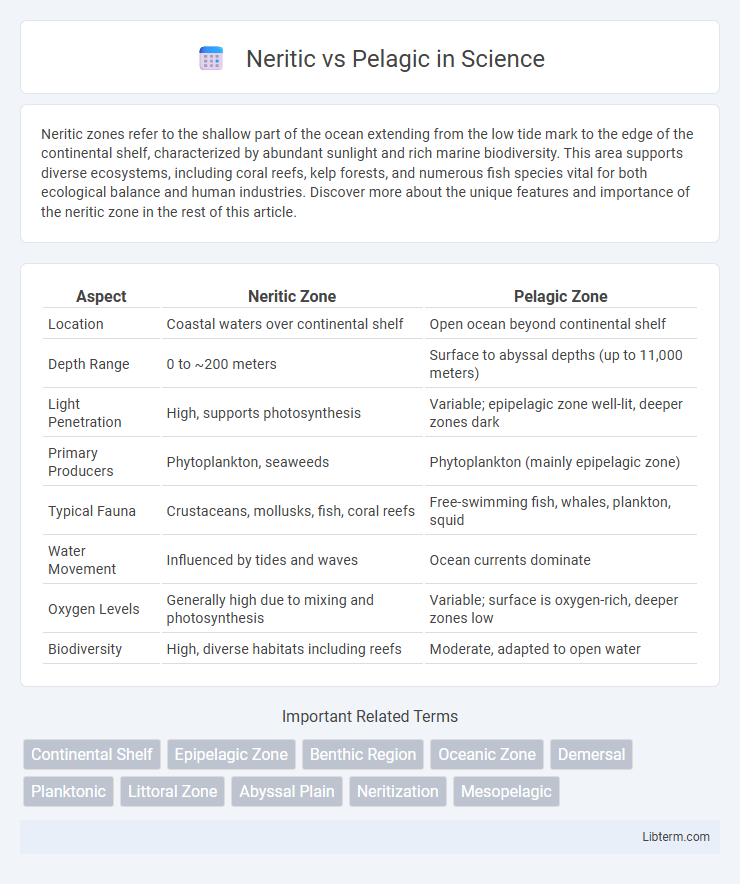Neritic zones refer to the shallow part of the ocean extending from the low tide mark to the edge of the continental shelf, characterized by abundant sunlight and rich marine biodiversity. This area supports diverse ecosystems, including coral reefs, kelp forests, and numerous fish species vital for both ecological balance and human industries. Discover more about the unique features and importance of the neritic zone in the rest of this article.
Table of Comparison
| Aspect | Neritic Zone | Pelagic Zone |
|---|---|---|
| Location | Coastal waters over continental shelf | Open ocean beyond continental shelf |
| Depth Range | 0 to ~200 meters | Surface to abyssal depths (up to 11,000 meters) |
| Light Penetration | High, supports photosynthesis | Variable; epipelagic zone well-lit, deeper zones dark |
| Primary Producers | Phytoplankton, seaweeds | Phytoplankton (mainly epipelagic zone) |
| Typical Fauna | Crustaceans, mollusks, fish, coral reefs | Free-swimming fish, whales, plankton, squid |
| Water Movement | Influenced by tides and waves | Ocean currents dominate |
| Oxygen Levels | Generally high due to mixing and photosynthesis | Variable; surface is oxygen-rich, deeper zones low |
| Biodiversity | High, diverse habitats including reefs | Moderate, adapted to open water |
Introduction to Marine Zones
The neritic zone extends from the low tide mark to the edge of the continental shelf, characterized by relatively shallow waters with abundant sunlight supporting diverse marine life and coral reefs. The pelagic zone begins beyond the continental shelf and includes the open ocean, where depths increase dramatically and light penetration decreases, hosting species adapted to varying pressure and low-light environments. These marine zones play crucial roles in ocean ecosystems, influencing biodiversity, nutrient cycles, and fisheries productivity.
Defining Neritic and Pelagic Zones
The neritic zone refers to the coastal ocean region extending from the low tide mark to the edge of the continental shelf, characterized by abundant sunlight and nutrient-rich waters supporting diverse marine life. In contrast, the pelagic zone encompasses the open ocean beyond the continental shelf, ranging from surface waters to the deep sea, with varying light penetration and fewer nutrients. These distinct zones influence marine ecosystems, species distribution, and biological productivity in oceanic environments.
Key Environmental Characteristics
The neritic zone, extending from the low tide mark to the edge of the continental shelf, is characterized by shallow, well-lit waters with high nutrient availability, promoting diverse marine life and abundant primary production. In contrast, the pelagic zone covers the open ocean beyond the continental shelf, featuring deeper waters with lower nutrient concentrations and greater light penetration variability, influencing distinct ecological communities adapted to these conditions. Salinity, temperature stability, and oxygen levels differ significantly between these zones, shaping their unique environmental dynamics and biological productivity.
Biodiversity in the Neritic Zone
The neritic zone, extending from the low tide mark to the edge of the continental shelf, hosts significantly higher biodiversity compared to the pelagic zone due to its nutrient-rich waters and sunlight penetration. This zone supports diverse marine life including coral reefs, fish, plankton, and benthic organisms, making it a critical habitat for many species. The abundance of primary producers in the neritic zone fuels complex food webs, enhancing ecological productivity and species richness.
Biodiversity in the Pelagic Zone
The pelagic zone, encompassing vast open ocean waters, hosts a unique biodiversity characterized by a wide range of planktonic organisms, free-swimming fish, and large marine mammals adapted to varying depths and light conditions. Compared to the neritic zone, the pelagic zone supports fewer species but includes highly specialized organisms such as bioluminescent creatures and migratory species that play crucial roles in oceanic food webs. This biodiversity is integral to global biogeochemical cycles and sustains commercial fisheries dependent on pelagic fish stocks like tuna and mackerel.
Light Penetration and Productivity
Neritic zones, located over continental shelves, receive high light penetration due to shallow depths, supporting dense photosynthetic activity and high primary productivity. Pelagic zones, encompassing open ocean areas, experience limited light penetration beyond the photic zone, resulting in lower productivity dominated by phytoplankton in surface waters. This disparity in light availability drives the contrast in biomass and ecological productivity between neritic and pelagic marine environments.
Nutrient Availability and Circulation
Neritic zones, located over continental shelves, experience higher nutrient availability due to constant input from terrestrial runoff and upwelling currents, fostering rich primary productivity. Pelagic zones, encompassing open ocean waters, often have lower nutrient concentrations as nutrients are diluted over vast areas and limited vertical mixing restricts nutrient replenishment in surface waters. Circulation patterns in neritic regions enhance nutrient retention, while pelagic areas rely on large-scale ocean currents and seasonal mixing to redistribute nutrients.
Adaptations of Marine Organisms
Marine organisms in the neritic zone exhibit adaptations such as enhanced sensory organs and strong swimming abilities to navigate shallow waters with variable light and currents. Pelagic species have evolved streamlined bodies and buoyancy control mechanisms to thrive in open-ocean environments with vast depths and minimal physical structures. Both zones feature specialized reproductive strategies and metabolic rates aligned with nutrient availability and pressure differences.
Human Impact and Conservation
Human activities such as coastal development, pollution, and overfishing heavily impact neritic zones, leading to habitat degradation and reduced biodiversity. Pelagic regions face threats from industrial-scale fishing, plastic pollution, and shipping traffic, disrupting marine ecosystems and food webs. Conservation efforts prioritize establishing marine protected areas, implementing sustainable fishing practices, and reducing land-based pollution to preserve both neritic and pelagic habitats.
Summary: Neritic vs Pelagic Comparison
The neritic zone encompasses shallow waters extending from the shoreline to the edge of the continental shelf, characterized by high nutrient availability and sunlight penetration supporting diverse marine life. In contrast, the pelagic zone refers to the open ocean beyond the continental shelf, with varying depths and lower nutrient concentrations, hosting different species adapted to open water conditions. These zones differ significantly in physical properties, biodiversity, and ecological roles within marine ecosystems.
Neritic Infographic

 libterm.com
libterm.com